Fall Steelhead Fishing: Proven Guide Tips And Tactics
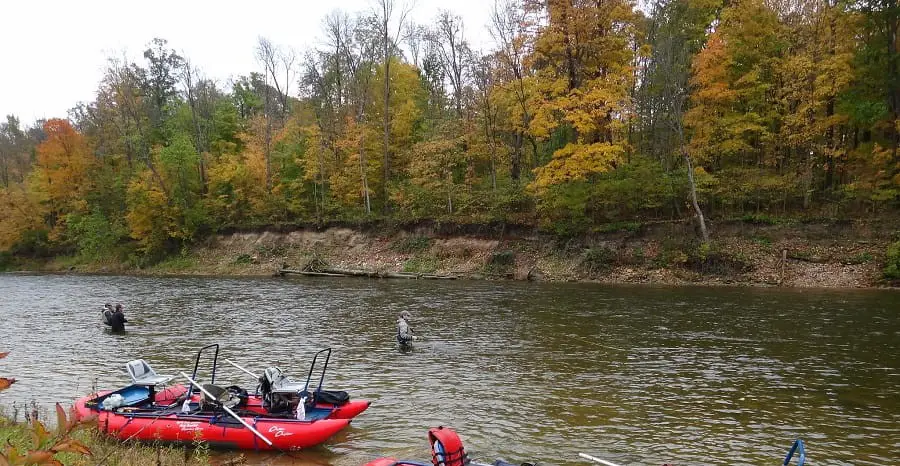
I have been guiding for steelhead for twenty-two years, and without hesitation, I’d say that fall steelhead fishing is my favorite time to be on the water. I know many other guides in my area that would agree.
It’s not unusual for me to be on the water daily and for over 50 days straight in the fall.
Being on the water daily from late September until late December gives me a serious advantage over other anglers. I know where the steelhead are each day, I know when they change holding locations and where to look for them based on river conditions and water temperatures, I know when they are moving and when they are holding, and I know how to adapt to their changing feeding behaviors.
But, If I don’t adapt to the conditions, my clients catch fewer steelhead, and so will you.
I also know when it’s time to change rivers.
I’m going to share my fall tactics and tips that I use to put over 400 steelhead in the net for my clients in the fall.
Fall Steelhead Fishing: What You Should Know
What I love about fall fishing is:
- Fishing Conditions: The rivers are usually more stable than in the spring, so fishing conditions seem more consistent, and flooded and unfishable rivers are less likely.
- Best Fishing Steelhead: Fall steelhead are strong and healthy from being out in the open water all summer. They will smash baits, flies, and lures, and they usually fight better than winter and spring steelhead.
- They’re Agressive Feeders: Fall steelhead will feed heavily when they enter the rivers in the fall because they are not focused on the spawn yet.
- Good Numbers: There can be a lot of steelhead in the river, pending conditions.
But fall steelhead also has its challenges:
- Low Water: Low water and no fish are a problem some years when traditional fall rains are late.
- Run Timing: During low-water years, the steelhead runs can be sporadic and harder to predict, especially on smaller streams.
- Water Temperatures: The water gets cooler by the day in the fall, and in some areas, the rivers will even freeze. Cooling water temperatures make the steelhead change their holding spots and their feeding behavior.
To keep my clients catching steelhead, I adapt and change with the steelhead. You should also adapt because a steelhead in October in 60-degree water temps behaves very differently than a steelhead in 45-degree water in early December.
Even the dropping air temps from ten degrees above freezing during the day to three below freezing overnight can drastically change the steelhead feeding behavior.
Early Fall Fishing For Steelhead (September and October)
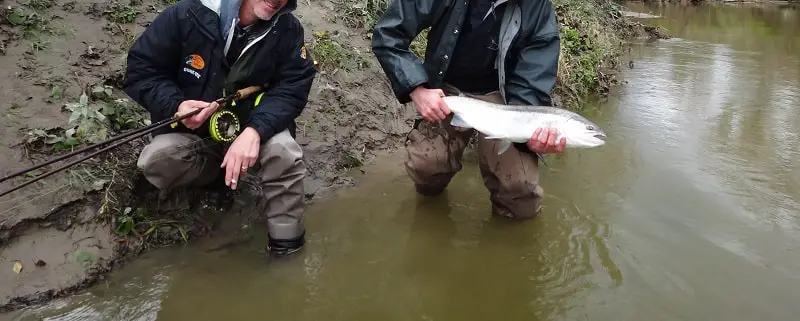
Early fall fishing often starts out with small sporadic steelhead runs triggered by cooler nights in September and October and by cool rains that raise water levels.
Some steelhead will even enter the river because they are following migrating salmon up the rivers.
Early Fall Tactics:
- Fish The Right River: If it hasn’t rained in a long time and the small rivers are too low, fish the bigger rivers because they can have fish moving in them even without an increase in water levels. After heavy rains, fish the smaller rivers or rivers that are clear and fishable and wait for the bigger rivers to settle down before you try to fish them.
- Know Where To Fish: In early fall, the steelhead are on the move and can be anywhere and everywhere. I look for travel routes and concentration spots. These could be spots just below rapids where the steelhead will hold. It could be the deeper side of the river where the current slows. I catch less fish in tail-outs and more fish in the head and middle of pools at this time of year.
- Fish Fast: The steelhead are agressive and are on the move. This is when lures and streamer flies can work well.
- Bigger and Brighter: The aggressive steelhead of early fall are more likely to hit bigger and brighter baits and lures, especially in the lower parts of the river.
- Water Temperature: From September to early November, I don’t find that water temperatures have a significant affect on the steelhead.
- Fish Behind Salmon: Use egg baits and egg flies and target the steelhead in the pockets, pools, and runs below spawning salmon.
- Fish Low Light: Mornings and late afternoon are often the best times to fish for steelhead at this time. In the mornings and evenings, I fish the top half of the pools as well as pockets and fast water.
- Mid-Day Fishing: By late morning and throughout the afternoon, especially under bright sun, low water, or when many anglers are on the river, the steelhead will hold in the deeper middle sections of the pool.
Mid-Fall Fishing: November
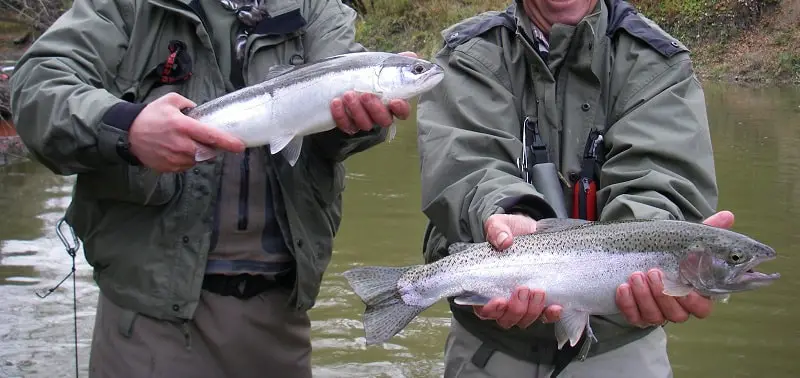
Mid-fall fishing starts around early November when the water temperature start getting below 50F. This is also the peak time for steelhead and is often when the biggest runs of steelhead happen.
This is also when the nights are much colder and can often drop below freezing temperatures, and this is when you need to start making some adjustments.
- Baits and Lures: All the same baits and lures that worked in early fall will also work anytime in November.
- Temperatures: This is when water temps can really fluctuate, which can make certain times of the day tough. Dropping water temps are bad, rising water temps are good, and stable temps are mostly good. You will need to adapt based on the temperature of the river.
- Holding Spots: Where the steelhead holds depends on the temperatures. Very cold air temperatures can drop water temperatures quickly overnight, slowing the steelhead’s migration. If water temps drop quickly overnight, early morning steelhead are more likely to hold in deeper and slower spots until water temps stabilize or increase.
- Feeding Times: Significant water temperature drops overnight can mean slow fishing early in the morning, and better fishing by late morning or at dusk.
- Migration Movements:
This period is when the most fall steelhead are caught simply because there are so many fish in the rivers, and they are still aggressive and will hit most baits.
Steelhead are cold-blooded and when the river temperatures drop drastically overnight, they can become sluggish and inactive.
Since the water temps and their activity levels fluctuate a lot this time of year. This is when I start rotating through my baits to figure out what they will eat. What they eat early in the morning might change by 11 am or at 2 pm. Rotating lures, baits, bait and lure sizes, and bait and lure colors significantly increases the amount of fish my clients catch.
Check out my page Best Steelhead Baits and The Best Lures For Steelhead Fishing
Late Fall Fishing For Steelhead
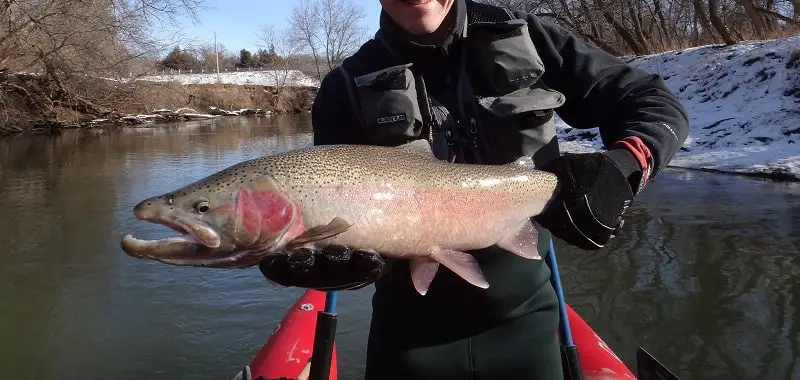
For many anglers, catching steelhead at this time of year can be tough. This is when many guys give up fishing for steelhead altogether. It’s either too cold for them to be standing on the river all day, or they just stop catching steelhead because they don’t understand how to catch them in very cold water.
Late fall fishing starts when the water temperature starts getting below 40F, which is usually around late November and through December. There are often lots of steelhead in the river at this time, so that is not the problem.
I tell my clients we are in the late fall or winter period when I start seeing ice on the edges of the river. These steelhead are cold, lethargic, and don’t act like early fall steelhead. This is what I do to keep my clients catching lots of steelhead.
- Fishing Time: I start later in the morning when the water temps stabilize or start to rise. This is when the steelhead will become active and start feeding.
- Fishing Spots: I locate slower, bigger, deeper spots. I avoid faster water, shallow runs, and pocket water.
- Fish Slower and Deeper: I use slower presentations, such as bait fishing or nymphing. I will use slower-moving lures, and if I swing flies, I mend to slow the fly down. I also fish everything deeper since most steelhead will be belly to the bottom and less likely to move far for a bait or lure.
- Smaller Baits and Lures: I have noticed a trend in steelhead taking smaller baits and lures when they are less active. Mid-day, I might upsize my baits and lures. I tend to start small, and if that doesn’t work, I increase my size.
- Dress Appropriately: This is when I and my clients start dressing for winter. I discuss this in more detail below.
Not understanding how fluctuating temps affect the fish is often most angler’s biggest problem at this time of year. This is almost time to start winter fishing tactics which I discuss on my page Winter Steelhead Fishing: Tips And Tactics Of Expert Guides.
I use the online USGS Stream flow charts to help me predict the steelhead runs, as well as estimate the water clarity and color of the river before I leave the house. I discuss how the numbers on the charts relate to fishing and how I determine water color and clarity on my page Stream Flow Data Related To Fishing.
Dress Right For Late Fall Fishing
Fishing in late fall is also tough on anglers who don’t know how to dress for the weather and the ice-cold water. As a guide who stands in the water almost all day and every day during this time, I’ve had to figure out how to stay warm, dry, and comfortable.
Layering, using the right waders, and gloves and hat are important.
I’ve used the advice and tips from other guides and what worked for me and put it on my page Fishing In The Winter – Stay Warm With These 10 Tips. These tips are great for late fall to early spring.
Once the late fall and winter season is over, spring steelhead fishing starts and that can require other methods and strategies to catch steelhead consistently. Check out my page on Spring Steelhead Fishing for more information and guide tips.
The Best Methods For Catching Fall Steelhead
The honest truth is that most methods of fishing that worked early in the fall will also work now, except that you may need to adjust those methods a bit. Slowing down and getting your bait, fly, or lure closer to the steelhead is more important now.
Casting a lure with a quick retrieve and high in the water column can be a big mistake at this time of year, and a lure that worked well in October might not be as effective when the water is cold and the fish are sluggish in December.
Fly fishing, float fishing, drift fishing, and lure fishing will all work when steelhead fishing in the fall, provided you do them correctly.
You can find out more about all the best methods that I use on my page Steelhead Fishing – Most Effective Methods For Steelhead.
Fall steelhead fishing requires that you adapt your presentation, baits, and locations based on the ever-changing environmental conditions at this time of year.
Tight Lines
Graham

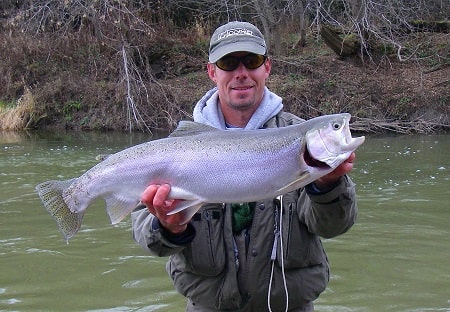
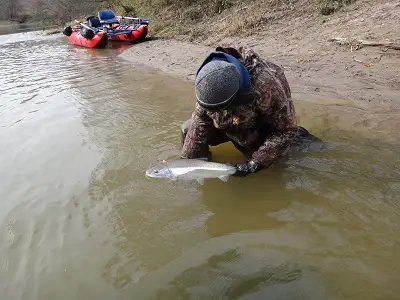
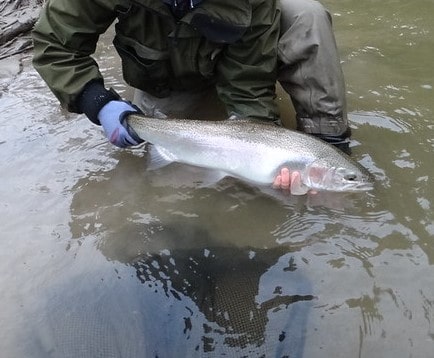
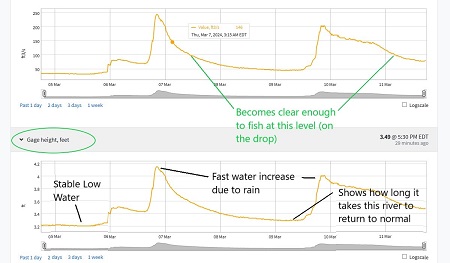
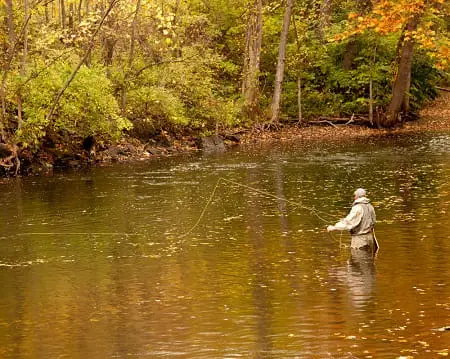
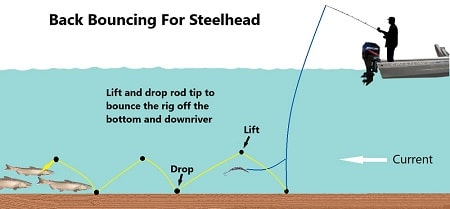
Will a single samlon egg work?
Hi Ben,
At times, single salmon eggs can be deadly productive.
Graham
Just wanted to say thank you for putting this information out there. I’ve enjoyed reading your tutorials and have gained more insight than I could have hoped for. I recently picked up my first centerpin and rod and reel (Raven Matrix fully ported) based on your suggestions as well as all the tackle for steelhead this year. My 14 year old and I will begin our Steelhead journey next week and with your tutelage I’m sure we’ll be having some fun. Thanks again!
Hello Graham,
Sorry for the dum question, but what do you call the head, tail of the pool. Is the head located up river?
Also, I learned this year euro nimphyng and I have been somewhat more productive than other years considering I started learning fly fishing this year. Would this still be a good method for the late fall, winter? or is it best to switch to indicator instead?
Hi David,
The head is the top of the pool, and the tail is the bottom of the pool.
First, I highly recommend getting good at both Euro and Indicator nymphing.
The reason is because late fall and winter fish will move into and hold in deeper slower water that is more suitable for indicators. However, if they are moving up the river, they can be found in pockets, runs, and shallower pools where Euro fishing can work better.
Also, on very windy days, or when you need to fish at a far distance, the indicator is better.
Hope that helps
Graham